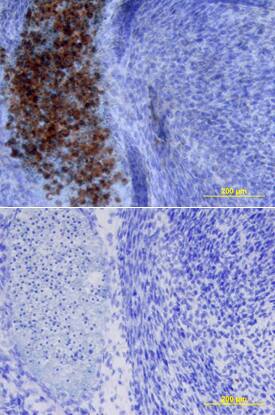Mouse SOST/Sclerostin Biotinylated Antibody
R&D Systems, part of Bio-Techne | Catalog # BAF1589


Key Product Details
Species Reactivity
Validated:
Cited:
Applications
Validated:
Cited:
Label
Antibody Source
Product Specifications
Immunogen
Gln24-Tyr211
Accession # NP_077769
Specificity
Clonality
Host
Isotype
Scientific Data Images for Mouse SOST/Sclerostin Biotinylated Antibody
SOST/Sclerostin in Mouse Embryo.
SOST/Sclerostin was detected in immersion fixed frozen sections of mouse embryo using Goat Anti-Mouse SOST/Sclerostin Biotinylated Antigen Affinity-purified Polyclonal Antibody (Catalog # BAF1589) at 15 µg/mL overnight at 4 °C. Tissue was stained using the Anti-Goat HRP-DAB Cell & Tissue Staining Kit (brown; Catalog # CTS008) and counterstained with hematoxylin (blue). Lower panel shows a lack of labeling if primary antibodies are omitted and tissue is stained only with secondary antibody followed by incubation with detection reagents. View our protocol for Chromogenic IHC Staining of Frozen Tissue Sections.Applications for Mouse SOST/Sclerostin Biotinylated Antibody
Immunohistochemistry
Sample: Immersion fixed frozen sections of mouse embryo (E15)
Western Blot
Sample: Recombinant Mouse SOST/Sclerostin (Catalog # 1589-ST)
Reviewed Applications
Read 1 review rated 4 using BAF1589 in the following applications:
Formulation, Preparation, and Storage
Purification
Reconstitution
Formulation
Shipping
Stability & Storage
- 12 months from date of receipt, -20 to -70 °C as supplied.
- 1 month, 2 to 8 °C under sterile conditions after reconstitution.
- 6 months, -20 to -70 °C under sterile conditions after reconstitution.
Background: SOST/Sclerostin
SOST, also known as Sclerostin, is a member of the cerberus/DAN family, a group of secreted glycoproteins characterized by a cysteine-knot motif. Cerberus/DAN family members are putative BMP antagonists, and include Dan, Cerberus, Gremlin, PRDC, and Caronte. While the overall sequence identity between members of the family is low, they have conserved spacing of six cysteine residues. Cerberus and Dan have an additional cysteine residue used for dimerization; however, SOST does not and is secreted as a monomer. SOST was originally identified as an important regulator of bone homeostasis. Positional cloning studies identified that mutations in the SOST gene can cause sclerosteosis and van Buchem disease, bone dysplasia disorders characterized by progressive skeletal overgrowth. Significant levels of SOST expression are detected in bone, cartilage, kidney, and liver. SOST is expressed by osteoclasts in developing bones of mouse embryos, including both intramembranously forming skull bones and endochondrally forming long bones. SOST plays a physiological role as a negative regulator of bone formation by repressing BMP-induced osteogenesis. SOST has been shown to have unique ligand specificity, binding BMP-5, -6, and -7 with high affinity and BMP-2 and -4 with low affinity. This seems to be the first example of a BMP antagonist being localized to osteoclasts, cells derived from the hematopoietic lineage, that function to degrade bone matrix. Recombinant human SOST preparations from R&D Systems bind BMP-5 and BMP-6 in a functional ELISA. Human and mouse SOST share 88% amino acid identity (1‑3).
References
- Kusu, N. et al. (2003) J. Biol. Chem. 278:24113.
- Balemans, W. et al. (2001) Hum. Mol. Genet. 10:537.
- Brunkow, M.E. et al. (2001) Am. J. Hum. Genet. 68:577.
Alternate Names
Gene Symbol
UniProt
Additional SOST/Sclerostin Products
Product Documents for Mouse SOST/Sclerostin Biotinylated Antibody
Product Specific Notices for Mouse SOST/Sclerostin Biotinylated Antibody
For research use only